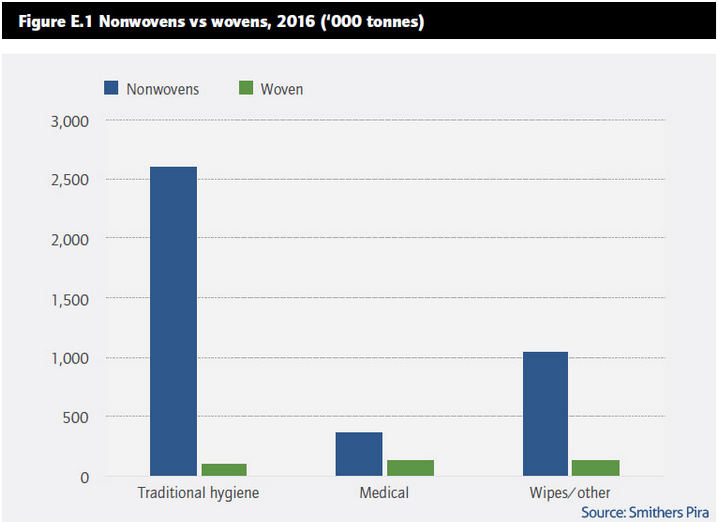
In 2016, according to Smithers Pira's 'the future of the global health market by 2021: Textiles vs non-woven fabrics' report, the global health market (baby diapers / diapers, women's sanitary pads and slivers, adult incontinence products and medical and rag markets) will consume 4.4 million tons, worth US $17 billion. The non-woven part of the market is expected to more than double from 2016 to 2021, as the market for large surgical gowns and shop orders continues to shift to global disposable non-woven products, while the non-woven industrial duster market benefits from the recent effective treatment of us EPS.
Growth of disposable and reusable products
In each of the three main components of the health market, disposable products are replacing or continue to replace reusable products.
In traditional health, it is a constant struggle between diapers / diapers and disposable products. In emerging markets, it is usually based on income decisions; once the population reaches the minimum GDP, they choose disposable diapers. In developed markets, decisions are often based on conservation. Here, a small number of consumers believe that reusable fabric based diapers / diapers are more ecologically protective than disposable products, and are willing to give up the convenience of disposable products.
In all cases, the global trend is for disposable products to exceed reusable products and nonwovens to exceed woven or textile products.

Disposable non-woven wipes and washing textiles / fabric products
The following issues slow down the transition from reusable to disposable.
It took nearly 30 years, but the U.S. Environmental Protection Agency (EPA) finally released the long-awaited final regulations on solvent contaminated wipes (also known as 'wipes regulations'), which better balanced the supervision between non washing wipes and wipes and washing towels.
In the previous proposal, the EPA made a conditional exclusion of the definition of hazardous waste related to non washing towel, and a conditional exclusion of the definition of solid waste related to washing towel. These exclusions apply only to wipes and shop towels themselves, EPA notes, any extracts from solvents left in containers will still be considered solid waste and may be subject to hazardous waste regulations.
Now, the requirement to achieve exclusion is almost equal between two types of wipe products.
Assuming that these requirements are met, non washing wipes will be able to be disposed of in a non hazardous waste landfill or hazardous waste landfill, or through a domestic waste burner or hazardous waste burner or hazardous waste boiler or industrial furnace. However, towels for washing are sent to industrial laundries or dry cleaners.
With the implementation of these new regulations (in most states), it is expected that disposable non-woven wipes will be re promoted in the United States (with global impact).
Economic comparison between disposable diapers / diapers and cloth / fabric diapers / diapers
It is generally considered that using cloth / fabric diapers / diapers is more economical, and the economy can offset the convenience advantage of disposable products.
Generally speaking, two years of disposable diaper use costs $2000 - 3000. At the same time, using diapers is only $800 - $1000, assuming that consumers wash them themselves. If the diaper washing service provided by the laundry is used, the cost is about the same as the disposable goods.
Therefore, for those who want to use diapers, the economy can be described, but users of disposable products can also point out the cost of diaper washing services. Diaper advocates point to potential uses that could be offered to future born children, while disposable advocates want cost accounting to include household washing, including labor costs. This is actually a trend of simultaneous growth of disposable diapers / diapers and diapers / diapers.
Potential of mixed nonwovens / textile products
The best example of this type of product is the growing market for hybrid diapers / diapers. There are many combinations of diapers with reusable parts:
Cloth diaper
'Double diapers' with diapers
Disposable diaper 'double diaper'
Mixed diaper
Multi purpose disposable shell, one-time built-in product (e.g. P & G's change'n go or KC has stopped production and depend boost for AI)
Hybrid diapers usually use a disposable insert with a reusable chassis or shell. This type of product has been common in adult incontinence for decades, but is relatively new for baby diapers. It is estimated that in developed regions such as North America and Western Europe, hybrid products now account for 80-85% of the non disposable diaper market. These five combinations describe the market for reusable diapers today. These reusable diapers have led to market growth in some mature regions and appear to represent the potential of hybrid products.
Demand for lighter weight fabrics / substrates in various health markets
One solution to improve sustainability (reduce waste, minimize raw material and energy use) and cost is to reduce the base weight of the substrate (weight per unit area). Both in textile and nonwovens, producers can improve their performance so that they can achieve the same effect with lower weight fabrics. Examples include the second surface layer (equivalent to a collection / dispersion layer) in women's health products, which falls from 80g / m2 to 60g / m2, and the diaper surface layer, which falls from 17g / m2 to 9g / m2. The same is true for washable wipes, which drop from over 100 grams per square meter to about 90 grams per square meter. Nonwoven fabric can obtain lower base weight than fabric more easily and economically.